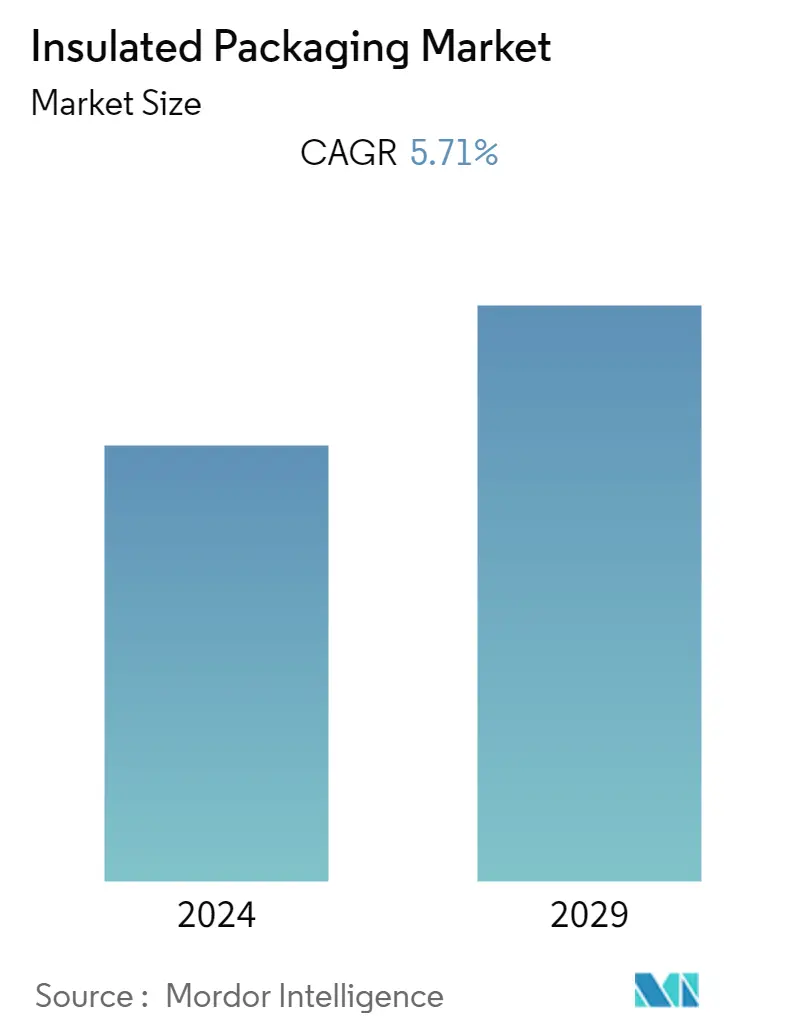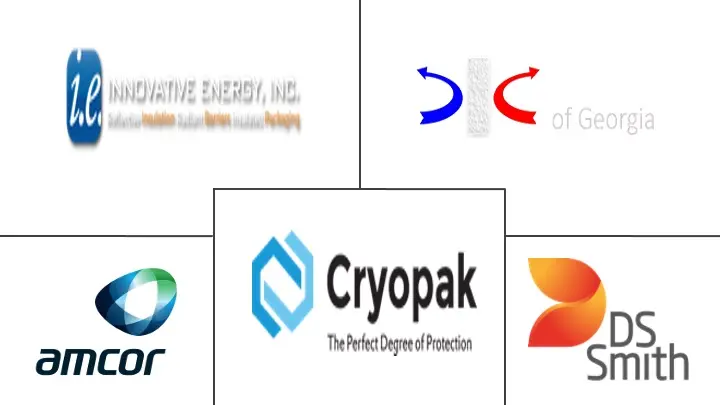Market Size of Insulated Packaging Industry

| Study Period | 2019 - 2029 |
| Base Year For Estimation | 2023 |
| CAGR | 5.71 % |
| Fastest Growing Market | Asia Pacific |
| Largest Market | North America |
| Market Concentration | Medium |
Major Players
*Disclaimer: Major Players sorted in no particular order |
Insulated Packaging Market Analysis
The insulated packaging market was valued at USD 14.15 billion in 2020 and is expected to reach a value of USD 19.65 billion by 2027, and grow at a CAGR of 5.71% over the forecast period (2022 - 2027). Insulation packaging is vital for combating energy losses during transportation and storage. Some of the significant characteristics of insulated packaging are high resistance to heat transfer, low cost, low weight, low moisture susceptibility, ease of fabrication and transportation, durability, and mechanical strength.
- Moreover, insulated packaging plays a significant role in various other end-user industries, such as pharmaceutical and electronics. Pharmaceutical is one of the major end users of these insulated packaging as the product is sensitive to temperature. The packaging of temperature-controlled pharmaceutical products and medical devices is witnessing considerable growth in the overall healthcare industry.
- The increase in the number of e-commerce websites for food and beverages and medicines is proliferating the need for delivery of perishable goods without any wastage. This is further increasing the adoption of insulated packaging by online grocery stores around the world. According to INE Spain, consumers who bought food and perishable goods online increased from 12.8% in 2015 to 18.6% in 2018.
- The major advancements in protective packaging in the past few years have led to the usage of new materials such as cotton and wool insulation to offer a bio-based approach to reducing carbon emissions. For instance, SwiftPak's PLA bioplastic Packaging complies with local home or garden compost standards in the UK. The method has brought benefits such as keeping the internal product's temperature within 4 degrees Celsius for up to 30 hours.
- As of May 2020, Softbox launched a new cardboard insulated shipper to deliver chilled food. This cardboard has been manufactured to offer effective insulation layers that are similar to those of traditional expanded polystyrene with similar efficiencies. By using its proprietary Thermaflute insulating technology, cardboard insulation packaging uses a single-use low-cost parcel shipper featuring 100% recycled corrugated cardboard and no plastic. Such an initiative has led Softbox to remove 74.5 tonnes of plastic per year from their food delivery boxes and reduce 50% of plastic on the same.
- The outbreak of a pandemic has led to record numbers of consumers shopping online for groceries and restaurants moving to off-premises formats. Then, coming to insulated packaging for temperature-sensitive products, the pharmaceutical sector has been demanding. Considering the spike in e-commerce, the insulated packaging is expected to see strong sales with smaller e-commerce and food delivery formats across meal kits and other perishable food and beverage items. As multiple packages containing fresh and frozen items require good insulation, pandemic-led behavioral change has led to packages being left outdoors for some time.
Insulated Packaging Industry Segmentation
Insulated packaging is a type of packaging that is used to ship temperature-sensitive products, such as food and beverages, pharmaceuticals, biologic materials, cosmetics, and chemicals, among others. It helps in maintaining product freshness and efficacy. The packaging controls and documents the temperature of a product throughout its entire distribution cycle. In other words, it is also known as an insulated shipping container.
| Material | |
| Plastic | |
| Wood | |
| Glass | |
| Other Materials |
| Product Type | |
| Pouch and Bags | |
| Box and Containers | |
| Other Product Types |
| End-user Application | |
| Food and Beverages | |
| Industrial | |
| Pharmaceuticals | |
| Beauty and Personal Care | |
| Other End-user Applications |
| Geography | |||||||
| |||||||
| |||||||
| |||||||
| Rest of the World |
Insulated Packaging Market Size Summary
The insulated packaging market is experiencing significant growth, driven by its essential role in minimizing energy losses during the transportation and storage of temperature-sensitive products. This type of packaging is characterized by its high resistance to heat transfer, cost-effectiveness, lightweight nature, and durability, making it indispensable in industries such as pharmaceuticals and electronics. The rise of e-commerce, particularly in the food and beverage sector, has further fueled the demand for insulated packaging, as it ensures the safe delivery of perishable goods without wastage. Innovations in materials, such as the use of bio-based insulators like cotton and wool, are also contributing to the market's expansion by offering environmentally friendly alternatives that help reduce carbon emissions.
The market is poised for continued growth, with the United States expected to lead due to its expanding retail food chains and burgeoning e-commerce industry. The increasing consumption of frozen foods in developed countries is also a key driver, necessitating the use of insulated packaging to maintain product quality during storage and transport. Regulatory frameworks, particularly in the food-contact packaging sector, are promoting the adoption of insulated solutions, further bolstering market growth. The industry is moderately fragmented, with numerous providers investing in research and development to innovate and meet the diverse needs of end-users. Recent advancements include the introduction of recyclable and compostable packaging solutions, highlighting the market's commitment to sustainability.
Insulated Packaging Market Size - Table of Contents
-
1. MARKET DYNAMICS
-
1.1 Market Overview
-
1.2 Industry Attractiveness - Porter's Five Force Analysis
-
1.2.1 Bargaining Power of Suppliers
-
1.2.2 Bargaining Power of Buyers/Consumers
-
1.2.3 Threat of New Entrants
-
1.2.4 Threat of Substitute Products
-
1.2.5 Intensity of Competitive Rivalry
-
-
1.3 Industry Value Chain Analysis
-
1.4 Market Drivers
-
1.4.1 Rising Consumption Of Perishables And Shift To Greener Materials
-
1.4.2 Growth in E-Commerce Driving Insulated Packaging Innovations
-
-
1.5 Market Restraints
-
1.5.1 Stringent Government Regulations Adherence Limiting Growth, Maintenance Costs, Raw Material Issues
-
-
1.6 Impact of COVID-19 on the Market
-
-
2. MARKET SEGMENTATION
-
2.1 Material
-
2.1.1 Plastic
-
2.1.2 Wood
-
2.1.3 Glass
-
2.1.4 Other Materials
-
-
2.2 Product Type
-
2.2.1 Pouch and Bags
-
2.2.2 Box and Containers
-
2.2.3 Other Product Types
-
-
2.3 End-user Application
-
2.3.1 Food and Beverages
-
2.3.2 Industrial
-
2.3.3 Pharmaceuticals
-
2.3.4 Beauty and Personal Care
-
2.3.5 Other End-user Applications
-
-
2.4 Geography
-
2.4.1 North America
-
2.4.1.1 United States
-
2.4.1.2 Canada
-
-
2.4.2 Europe
-
2.4.2.1 Germany
-
2.4.2.2 United Kingdom
-
2.4.2.3 France
-
2.4.2.4 Italy
-
2.4.2.5 Rest of Europe
-
-
2.4.3 Asia-Pacific
-
2.4.3.1 China
-
2.4.3.2 Japan
-
2.4.3.3 India
-
2.4.3.4 Australia
-
2.4.3.5 Rest of Asia-Pacific
-
-
2.4.4 Rest of the World
-
-
Insulated Packaging Market Size FAQs
What is the current Insulated Packaging Market size?
The Insulated Packaging Market is projected to register a CAGR of 5.71% during the forecast period (2024-2029)
Who are the key players in Insulated Packaging Market?
Amcor PLC, Cryopak, Davis Core & Pad Company, DS Smith PLC and Innovative Energy Inc. are the major companies operating in the Insulated Packaging Market.

